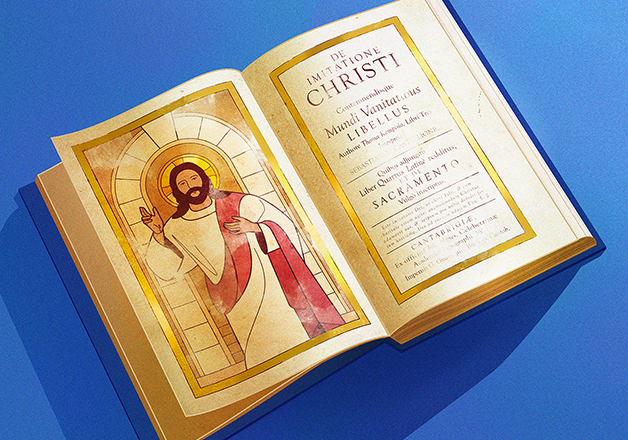“The Imitation of Christ”: Table of Contents
“The Imitation of Christ,” which was the foundation of Hallow’s 2023 Pray40 Lent prayer challenge, has inspired the faith lives of millions of people spanning hundreds of years.
Despite the countless lives it’s changed, it’s a book that still remains a bit of a mystery to many Christians.
Learn all about “The Imitation of Christ” and join Hallow’s Imitation of Christ prayer challenge this fall.
History
“The Imitation of Christ” was published anonymously but is believed to have been written by a German-Dutch monk named Thomas à Kempis.
Kempis was a Dutch/German monk who was born in 1380 and whose duties as a monk included writing, transcribing and instruction.
“The Imitation of Christ” began as an instruction for other monks, Kempis wrote it as a conversation between Christ and His disciple, as a daily meditation resource.
Kempis published it sometime between 1420 and 1427 in the Netherlands, and it rapidly soared in popularity, with 745 different editions published across more than eight languages by 1650.
The Four Books of ‘The Imitation of Christ’
Similar to the Bible, Catholics and Protestants use different translations of “The Imitation of Christ”, yet the main divisions of the book are the same.
The entire work features four “books,” each of which addresses a different aspect of spirituality and faith:
- Book 1: Admonitions, Useful for the Spiritual Life
- Book 2: Admonitions Concerning Internal Things
- Book 3: Of Internal Consolation
- Book 4: Concerning the Holy Communion.
Each book uses a similar language and tone that is very direct and, at times, strongly worded.
One person reviewing the book on the Catholicism subreddit of Reddit said they were “shocked” by the tone at first, suggesting that type of direct language was more common in the Middle Ages than it is now. However, they went on to describe the book as “soul-enriching.”
It focuses on humility, discipline and love, with an eye towards imitating Jesus on a daily basis.
“No sin will there be which shall not be visited with its own proper punishment,” Kempis wrote. “The proud shall be filled with utter confusion, and the covetous shall be pinched with miserable poverty.”
Much like the message of Jesus Himself, the words of Kempis were rather counter-cultural, both when “The Imitation of Christ” was first published as well as in modern times.
“He unsettles the comfortable pieties of modernity,” wrote Robert Miola.
Despite the challenging tone (or perhaps because of it!), Kempis’s masterpiece exploded in popularity almost immediately.
Popularity
As Maximilian Von Habsburg points out in his book “Catholic and Protestant Translations of the Imitatio Christi, 1425–1650: From Late Medieval Classic to Early Modern Bestseller,” the sheer volume of different editions published is a testament to the book’s popularity.
“The number of editions is testimony to the text’s persistent appeal,” he wrote, “especially since the number of copies of a specific edition is seldom quantifiable.”
Von Habsburg also points out that the book inspired so much further writing, in the following centuries, people citing The Imitation of Christ in their writing did not include the book in their bibliographies “on the basis that it was too common.”
In other words, people would cite lines from “The Imitation of Christ” and just assume that readers would know the reference. Few-if any–books today enjoy such wide-reaching popularity!
Among those impacted by the book were future saints.
Impact on Saints
St. Thérèse of Lisieux, one of the four female doctors of the church, famously appreciated “The Imitation of Christ.”
“For a long time I had nourished my spiritual life with the ‘fine flour’ contained in “The Imitation of Christ.” It was the only book which did me good, for I had not yet found the treasures hidden in the Holy Gospels. I always had it with me, to the amusement of my people at home,” she wrote.
During the 11 months in which he lived in a cave in Manresa, Spain, St. Ignatius “grew to love” “The Imitation of Christ” and shortly after, penned his now famous Spiritual Exercises (and daily examen).
“Since then he had never wished to read any other devotional book. He recommended it to all he had dealings with,” wrote Gonçalves da Câmara, the Portuguese Jesuit to whom Ignatius dictated his autobiography. “After dinner and at other times he would open it at random and he always came across something that was close to his heart at that time and which he needed.”
In an August 2006 General Audience, Pope Benedict XVI called “The Imitation of Christ” “that golden text of spirituality.”
But you don’t need to be a saint or a pope for “The Imitation of Christ” to have a major impact on your life.
Praying with ‘The Imitation of Christ’
Just as “The Imitation of Christ” shaped the faith lives of saints, it can ignite your own faith life as well.
Sparked by the popularity of Hallow’s Pray40 Lent Prayer Challenged centered on “The Imitation of Christ,” Hallow is excited to launch a new daily content series exploring this landmark work of spiritual guidance.
Join Jim Caviezel, the actor who portrayed Jesus in the Passion of the Christ, and Sr. Orianne in reading and reflecting on one chapter of the book each day, journeying through the entirety of The Imitation of Christ.
